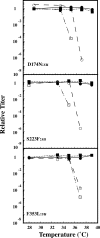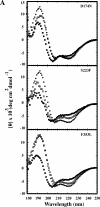GroEL/S substrate specificity based on substrate unfolding propensity
- PMID: 17441504
- PMCID: PMC1852890
- DOI: 10.1379/csc-219r.1
GroEL/S substrate specificity based on substrate unfolding propensity
Abstract
Phage P22 wild-type (WT) coat protein does not require GroEL/S to fold but temperature-sensitive-folding (tsf) coat proteins need the chaperone complex for correct folding. WT coat protein and all variants absolutely require P22 scaffolding protein, an assembly chaperone, to assemble into precursor structures termed procapsids. Previously, we showed that a global suppressor (su) substitution, T1661, which rescues several tsf coat protein variants, functioned by inducing GroEL/S. This led to an increased formation of tsf:T1661 coat protein:GroEL complexes compared with the tsf parents. The increased concentration of complexes resulted in more assembly-competent coat proteins because of a shift in the chaperone-driven kinetic partitioning between aggregation-prone intermediates toward correct folding and assembly. We have now investigated the folding and assembly of coat protein variants that carry a different global su substitution, F170L. By monitoring levels of phage production in the presence of a dysfunctional GroEL we found that tsf:F170L proteins demonstrate a less stringent requirement for GroEL. Tsf:F170L proteins also did not cause induction of the chaperones. Circular dichroism and tryptophan fluorescence indicate that the native state of the tsf: F170L coat proteins is restored to WT-like values. In addition, native acrylamide gel electrophoresis shows a stabilized native state for tsf:F170L coat proteins. The F170L su substitution also increases procapsid production compared with their tsf parents. We propose that the F170L su substitution has a decreased requirement for the chaperones GroEL and GroES as a result of restoring the tsf coat proteins to a WT-like state. Our data also suggest that GroEL/S can be induced by increasing the population of unfolding intermediates.
Figures







Similar articles
-
'Let the phage do the work': using the phage P22 coat protein structures as a framework to understand its folding and assembly mutants.Virology. 2010 Jun 5;401(2):119-30. doi: 10.1016/j.virol.2010.02.017. Epub 2010 Mar 16. Virology. 2010. PMID: 20236676 Free PMC article. Review.
-
A second-site suppressor of a folding defect functions via interactions with a chaperone network to improve folding and assembly in vivo.Mol Microbiol. 2004 Nov;54(4):1036-50. doi: 10.1111/j.1365-2958.2004.04326.x. Mol Microbiol. 2004. PMID: 15522085
-
A concerted mechanism for the suppression of a folding defect through interactions with chaperones.J Biol Chem. 2004 Apr 23;279(17):17473-82. doi: 10.1074/jbc.M400467200. Epub 2004 Feb 4. J Biol Chem. 2004. PMID: 14764588
-
GroEL and GroES control of substrate flux in the in vivo folding pathway of phage P22 coat protein.J Biol Chem. 1998 Oct 16;273(42):27236-44. doi: 10.1074/jbc.273.42.27236. J Biol Chem. 1998. PMID: 9765246
-
Molecular chaperone GroEL/ES: unfolding and refolding processes.Biochemistry (Mosc). 2013 Dec;78(13):1405-14. doi: 10.1134/S0006297913130038. Biochemistry (Mosc). 2013. PMID: 24490731 Review.
Cited by
-
Polyhead formation in phage P22 pinpoints a region in coat protein required for conformational switching.Mol Microbiol. 2007 Sep;65(5):1300-10. doi: 10.1111/j.1365-2958.2007.05868.x. Epub 2007 Aug 3. Mol Microbiol. 2007. PMID: 17680786 Free PMC article.
-
Nature's favorite building block: Deciphering folding and capsid assembly of proteins with the HK97-fold.Virology. 2015 May;479-480:487-97. doi: 10.1016/j.virol.2015.02.055. Epub 2015 Apr 8. Virology. 2015. PMID: 25864106 Free PMC article. Review.
-
'Let the phage do the work': using the phage P22 coat protein structures as a framework to understand its folding and assembly mutants.Virology. 2010 Jun 5;401(2):119-30. doi: 10.1016/j.virol.2010.02.017. Epub 2010 Mar 16. Virology. 2010. PMID: 20236676 Free PMC article. Review.
-
Highly specific salt bridges govern bacteriophage P22 icosahedral capsid assembly: identification of the site in coat protein responsible for interaction with scaffolding protein.J Virol. 2014 May;88(10):5287-97. doi: 10.1128/JVI.00036-14. Epub 2014 Mar 5. J Virol. 2014. PMID: 24600011 Free PMC article.
References
Publication types
MeSH terms
Substances
Grants and funding
LinkOut - more resources
Full Text Sources
Research Materials
